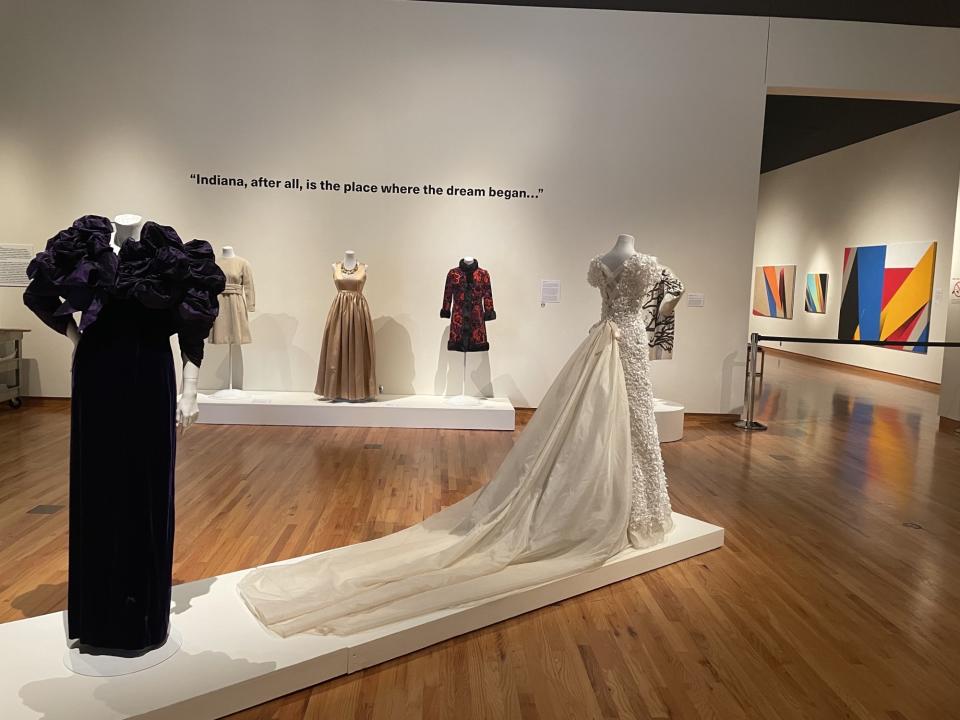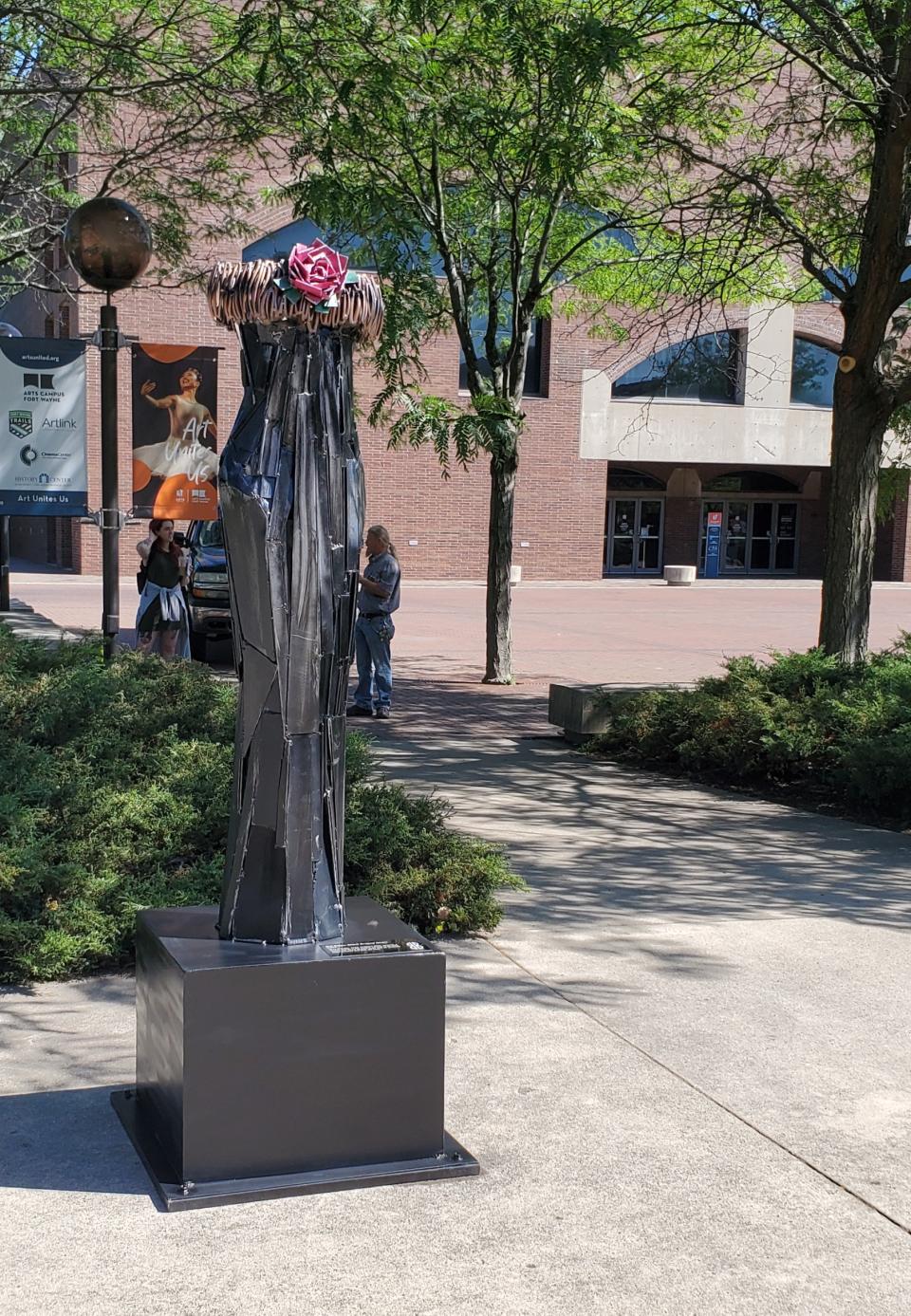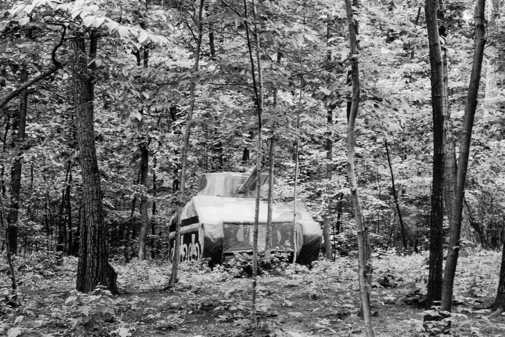Bill Blass 100-day Celebration Gets Underway in U.S.

However anticipatory Bill Blass may have been in predicting the winds of fashion, it is safe to say the late designer never would have forecasted the cyclone of a celebration underway in his hometown today.
While some designers unmistakably think about their legacies in their lifetimes, Blass, like his peers and successors, probably would not have envisioned a posthumous extravaganza that would call for three major exhibitions — outdoor sculptures inspired by his designs, 20-plus life-size cardboard cutouts stationed in local businesses, or a display of two Blass-designed Lincoln Continentals in Fort Wayne, Indiana.
More from WWD

Photo Courtesy
Aptly named “Bill Blass Blast: 100 Days of Bill Blass,” the spectacular got rolling Wednesday in honor of what would have been Blass’ 100th birthday. Needless to say, there’s a lot to keep track of, so there’s a “Where’s Bill” map, highlighting a dozen key stops, including Blass’ childhood home and a historic bridge named in his honor. The designer, who retired in 2000 and died two years later, cemented his status as a premier American designer in New York City, but he never lost sight of his Midwestern upbringing.
Exhibitions about Blass are on view at the Fort Wayne Museum of Art, The History Center and the Veteran’s National Memorial Shrine & Museum. The writing on one of the walls in the art museum captures it all with a quote from Blass: “Indiana, after all, is the place where the dream began…”

Photo Courtesy
While the Yves Saint Laurent 60th anniversary exhibition that bowed earlier this year was spread across six museums in Paris, the Blass one is the first to overtake an entire community. The project’s ringleader Kathy Carrier didn’t know Blass personally, but she has become an aficionado of his life. The cardboard versions of Blass depict him in various life stages — with a mannequin, bounding forward, and as a member of the U.S. Army’s World War II “Ghost Army,” the 23rd Headquarters Special Troops that was its first mobile, multimedia, tactical deception unit.
Carrier and her team have been dragging the gigantic cardboard cutouts in and out of cars to drop them off in places like the local public library and Oh Five Scoop, where a Bill Blass sundae based on his favorite version can be had. That has prompted a lot of discussion in the city of 300,000 — people are asking, “‘Who is that? And what are you doing with that?’” Carrier said with a laugh Tuesday. “So there are ‘Where’s Bill?’ sightings all over town.”
Puns abound. Case in point, the “Blassport” is a checklist for children to complete Blass-related activities and get a stamp that scores them a free ice cream cone. Video footage of Blass will appear on a Jumbotron during the July 3 Philharmonic Patriotic Pops. There will also be a cutout of Blass and a regulation-size army tank and a Jeep.
Carrier’s favorite most laughable moment happened, during a visit to Bill Blass Ltd.’s New York offices. Expecting to find “maybe a filing cabinet” with memorabilia, Carrier and two team members were bowled over to find 500 cases of documents and 1,500 dresses. “We had no idea. It was an amazing treasure hunt. Prior to that, we were ordering things on Poshmark from Bill Blass Originals — a pair of sunglasses here or a scarf or a tie,” she said. “As we stood there, I just started whooping and hollering, screaming and laughing — and then I started crying. It was just so remarkable and funny.”

Photo Courtesy
Friends and associates of the late designer donated items that were owned or created by him to organizers. Each is being digitally archived by the Allen County Public Library and a Bill Blass Archive Museum is being started in Ft. Wayne. Carrier’s a-ha moment for the museum occurred during a recent concert by The Lumineers in Cincinnati. After spotting how the rock band had showcased their memorabilia in 10-foot-high portable trunks, she decided, “This is it! Bill Blass did 30,000 miles [of travel] a year for trunk shows to get to women to hear what they had to say about his designs.”
As a result, the Blass museum will be a roving one that will use similar oversized trunks with wheels. By transporting its holdings to different areas, more people will have access. The aim is for a fourth-quarter opening. Carrier said, “I just laughed and giggled at The Lumineers’ concert because that was the last reason I was there. But literally everywhere we go, we run into ideas that we’re using for our Bill Blass celebration.”
The festivities kicked off Wednesday with a press conference, where Ft. Wayne Tom Henry proclaimed it was Bill Blass Day. It’s too soon to estimate the potential economic impact and current interest, a Visit Fort Wayne representative said Tuesday. “With everything just kicking off, it will be a scenario of people not yet having recognized Bill Blass’ legacy in connection to Fort Wayne. Fort Wayne is a humble and creative city and Bill is just a shining example of that,” she said.
Carrier has invested between $25,000 and $30,000. In August, a local radio station will encourage listeners and social media followers to canvas the city for Blass-centric destinations and answer questions about his life for prizes. Carrier explained, “I really like competitions, building a community spirit and hokey, crazy things. It’s kind of like ‘Where’s Waldo?’ I’m a geocacher so I’m curious about scavenger hunts.”
Conversations about Blass with such friends as Cathy Horyn, his former butler Alfred McGloin and personal assistant Yvonne Miller are being recorded and will be archived. Harper’s Bazaar alum Marilyn Kirschner clued in Carrier to the Blass-ism “That’s really snappy,” which was what the designer said if he really liked a design on someone, snapping his fingers for further effect, Carrier said. “Of course, our whole project team is running around town and telling each other we look snappy, which is ridiculous. We don’t. We’re just Indiana people.”
Noting how a Facebook post of Blass’ meatloaf recipe garnered 8,300 likes, she said, “You can tell Bill’s from the Midwest because everybody here eats meatloaf.” From her standpoint, the three-month extravaganza is already a success, since there have been conversations about Blass with people of all ages in the community who had no idea who he was, or about his fashion career and World War II heroism. The local PBS station’s recent coverage of the celebration has drummed up interest. Upcoming PBS airings include an interview with author, filmmaker and Ghost Army Legacy Project president Rick Beyer, who will headline a few Blass events.

Photo Courtesy The Ghost Army Legacy Project
An inflatable tank reminiscent of the ones used during WWII will help to bring Blass’ military service to life. Compact enough to be transported in a duffel bag, once inflated, the replica is upward of 8-feet high, 19-feet long and 10-feet wide. The Ghost Army conducted 20 deception missions in Europe with inflatable tanks and other artifacts, in France, Luxembourg and Germany, Beyer said, noting how they made stops at the Battle of the Bulge and The Crossing of the Rhine River and “really are the unsung heroes of World War II.”

Photo Courtesy The Ghost Army Legacy Project
Blass’ unit included the famous minimalist painter Ellsworth Kelly, wildlife artist Arthur Singer and fashion designer George Nardiello, who designed dresses for Marilyn Monroe. Traces of how this military experience affected Blass can be seen in a 56-page diary kept by Blass’ friend and fellow soldier Bob Tompkins that Blass’ mother later typed the contents of after the war. (It can be found online on the Ghost Army site.) It was penned in a 2-inch-by-3-inch book, since keeping a diary was against all regulations for someone in a secret unit, Beyer said.
Through interviews with other soldiers, Beyer learned of Blass’ “very positive attitude about everything,” he said. “Representative of a lot of these guys [at that time, they thought] ‘What an amazing way to get out of my regular existence. I am now with the U.S. Army. I am now in Europe. I am in Paris. We’re doing this mission that is kind of dangerous, but it’s not as bad as being a front-line soldier.’”

Image Courtesy The Ghost Army Legacy Project
While other servicemen sketched bombed-out villages, orphans and fellow soldiers in their wartime notebooks, Blass was sketching women’s fashion, Beyer said. “I don’t know the degree to which these are things that he was imagining or based on what he was seeing. He was in Paris in 1944 and some other major cities in Europe. I think it was helping to inspire him,” he said. “There always seemed to be a certain military cut to Bill Blass’ stuff. It always seemed to have some echoes of army in there.”

tompkins
True to form, when Blass was issued his military uniform, he took it apart and tailored it back together so that” he had the best-looking enlisted man’s uniform in the United States Army,” said Beyer, who learned that in an interview with another soldier. The cover of his wartime notebook is Blass’ sketch of mirrored “Bs,” which later became the logo for his company. “So he knew what he wanted to do. He was thinking ahead,” Beyer said.
Madonna Hanna is among the fashion-minded contributors who volunteered their Blass-related knowledge after learning about the celebration. A questionnaire that Blass responded to in 1989 for her fashion merchandising class in Tacoma, Washington, is on view at Fort Wayne’s Museum of Art. His responses to 21 questions indicated that he had at that time five assistant designers, whom he personally hired. As for what his company grossed annually, Blass said couture alone generated $10 million. (Ten years later the designer sold his company for $50 million to Michael Groveman.)
In the questionnaire, Blass singled out “Yves St. Laurent” as the person he most admired in the fashion industry and credited Vogue’s Baron Niki de Gunzburg for believing in him enough to give him a break. “A healthy attitude about not being a ‘clothes horse’” was what he liked most about his customers. The designer’s personal philosophy of life amounted to “involvement in career, art and people.” Inspired by movies and fashion magazine to pursue a career, Blass said draping fabric was the solution when stuck for a creative idea.
Designing 125 items each season in sizes 4 to 12, the designer always preferred to use red and beige. (He discarded the original questionnaire and retyped it using a beige typewriter ribbon, signed it in beige ink and mailed the document in a beige business envelope.) Traveling twice a month, Blass said the price dictated who his customers were and prices were tied to fabric costs and union labor. Asked what he was most looking forward to accomplishing in the 21st century, Blass replied, “Staying alive.”
Given the breadth of the festivities and the plans for a portable museum, that somehow seems possible now.
FOR MORE FROM WWD.COM, SEE:
Brands Continue to Support Title IX 50 Years Later
Hotel Hennes to Pop Up on the Lower East Side
Ukrainian Artist Floweirdy Creates Beauty Despite War
Best of WWD
Sign up for WWD's Newsletter. For the latest news, follow us on Twitter, Facebook, and Instagram.

